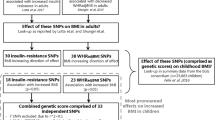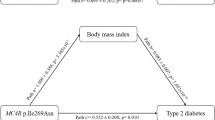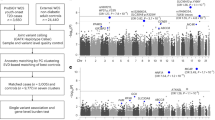Abstract
In millions of people, obesity leads to type 2 diabetes (T2D; also known as non-insulin-dependent diabetes mellitus1). During the early stages of juvenile obesity, the increase of insulin secretion in proportion to accumulated fat balances insulin resistance and protects patients from hyperglycaemia2. After several decades, however, β-cell function deteriorates and T2D develops in approximately 20% of obese patients3,4. In modern societies, obesity has thus become the leading risk factor for T2D (ref. 5). The factors that predispose obese patients to alteration of insulin secretion upon gaining weight remain unknown. To determine which genetic factors predispose obese patients to β-cell dysfunction, and possibly T2D, we studied single-nucleotide polymorphisms (SNPs) in the region of the insulin gene (INS) among 615 obese children. We found that, in the early phase of obesity, alleles of the INS variable number of tandem repeat (VNTR) locus are associated with different effects of body fatness on insulin secretion. Young obese patients homozygous for class I VNTR alleles secrete more insulin than those with other genotypes.
This is a preview of subscription content, access via your institution
Access options
Subscribe to this journal
Receive 12 print issues and online access
$209.00 per year
only $17.42 per issue
Buy this article
- Purchase on Springer Link
- Instant access to full article PDF
Prices may be subject to local taxes which are calculated during checkout


Similar content being viewed by others

References
Kopelman, P.G. Obesity as a medical problem. Nature 404, 635–643 (2000).
Le Stunff, C. & Bougnères, P. Early changes in postprandial insulin secretion, not in insulin sensitivity, characterize juvenile obesity. Diabetes 43, 696–702 (1994).
Pedersen, P. The impact of obesity on the pathogenesis of non-insulin-dependent diabetes mellitus. Diab. Metab. Rev. 5, 505–509 (1989).
Brancati, F.L., Wang, N.Y, Mead, L.A, Liang, K.Y. & Klag, M.J. Serum and dietary magnesium and the risk for type 2 diabetes mellitus: the Atherosclerosis Risk in Communities Study. Arch. Intern. Med. 159, 957–963 (1999).
Hill, J.O. & Peters, J.C. Environmental contributions to the obesity epidemic. Science 280, 1371–1374 (1998).
Lucassen, A.M. et al. Susceptibility to insulin dependent diabetes mellitus maps to a 4.1 kb segment of DNA spanning the insulin gene and associated VNTR. Nature Genet. 4, 305–310 (1993).
Bennett, S.T. & Todd, J.A. Human type 1 diabetes and the insulin gene: principles of mapping polygenes. Annu. Rev. Genet. 30, 343–370 (1996).
Karam, J.H., Grodsky, G.M. & Forsham, P.H. Excessive insulin response to glucose in obese subjects as measured by immunochemical assay. Diabetes 12, 197–204 (1963).
Kennedy, C.G., German, M.S. & Rutter, W.J. The minisatellite in the diabetes susceptibility locus IDDM2 regulates insulin transcription. Nature Genet. 9, 293–298 (1995).
Lucassen, A.M. et al. Regulation of insulin gene expression by the IDDM associated, insulin locus haplotype. Hum. Mol. Genet. 4, 501–506 (1995).
Bennett, S.T. et al. Susceptibility to human type 1 diabetes at IDDM2 is determined by tandem repeat variation at the insulin gene minisatellite locus. Nature Genet. 9, 284–292 (1995).
Snieder, H., Boomsma, D.I., Van Doornen, J.J.P. & Neale, M.C. Bivariate genetic analysis of fasting insulin and glucose levels. Genet. Epidemiol. 16, 426–446 (1999).
Owerbach, D., Poulsen, S., Billesbolle, P. & Nerup, J. DNA insertion sequences near the insulin gene affect glucose regulation. Lancet 1, 880–883 (1982).
Permutt, A., Rotwein, P., Andreone, T., Ward, K. & Porte, D. Islet β-cell function and polymorphism in the 5′-flanking region of the human insulin gene. Diabetes 34, 311–314 (1985).
Weaver, J.U., Kopelman, P.G. & Hitman, G.A. Central obesity and hyperinsulinaemia in women are associated with polymorphism in the 5′ flanking region of the human insulin gene. Eur. J. Clin. Invest. 22, 265–270 (1992).
Huxtable, S.J. et al. Analysis of parent-offspring trios provides evidence for linkage and association between the insulin gene and type 2 diabetes mediated exclusively through paternally transmitted class III variable number tandem repeat alleles. Diabetes 49, 126–130 (2000).
Carmelli, D., Cardon, L.R. & Fabsitz, R. Clustering of hypertension, diabetes, and obesity in adult male twins: same genes or environment? Am. J. Hum. Genet. 55, 566–573 (1994).
Ahmed, S. et al. INS VNTR allelic variation and dynamic insulin secretion in healthy adult non-diabetic Caucasian subjects. Diab. Metab. 16, 910–917 (1999).
Ong, K.K.L. et al. The insulin gene VNTR, type 2 diabetes and birth weight. Nature Genet. 21, 262–263 (1999).
Eaves, I.A. et al. Transmission ratio distortion at the INS-IGF2 VNTR. Nature Genet. 22, 324 (1999).
Cavalli-Sforza, L.L., Menozzi, P. & Piazza, A. History and Geography of Human Genes (Princeton University Press, Princeton, 1994).
Julier, C. et al. Insulin-IGF2 region on chromosome 11p encodes a gene implicated in HLA-DR4-dependent diabetes susceptibility. Science 354, 155–159 (1991).
Fallin, D. & Schork, N. Accuracy of haplotype frequency estimation for biallelic loci, via the expectation-maximization algorithm for unphased diploid genotype data. Am. J. Hum. Genet. 67, 947–959 (2000).
Acknowledgements
We thank A. Dermane for clinical assistance; M. Delpech, F. Amalric, C. Julier and B. Bihain for discussions; Y. Lefourn and N. Lahlou for insulin measurements; and C. Dos Santos for genotyping.
Author information
Authors and Affiliations
Corresponding author
Rights and permissions
About this article
Cite this article
Le Stunff, C., Fallin, D., Schork, N. et al. The insulin gene VNTR is associated with fasting insulin levels and development of juvenile obesity. Nat Genet 26, 444–446 (2000). https://doi.org/10.1038/82579
Received:
Accepted:
Issue Date:
DOI: https://doi.org/10.1038/82579
This article is cited by
-
Association of tyrosine hydroxylase 01 (TH01) microsatellite and insulin gene (INS) variable number of tandem repeat (VNTR) with type 2 diabetes and fasting insulin secretion in Mexican population
Journal of Endocrinological Investigation (2023)
-
Fetal growth is associated with CpG methylation in the P2 promoter of the IGF1 gene
Clinical Epigenetics (2018)
-
The association of insertions/deletions (INDELs) and variable number tandem repeats (VNTRs) with obesity and its related traits and complications
Journal of Physiological Anthropology (2017)
-
Challenges in reproducibility of genetic association studies: lessons learned from the obesity field
International Journal of Obesity (2013)
-
Detection of single nucleotide polymorphisms by the specific interaction between transition metal ions and mismatched base pairs in duplex DNA
Transition Metal Chemistry (2011)


